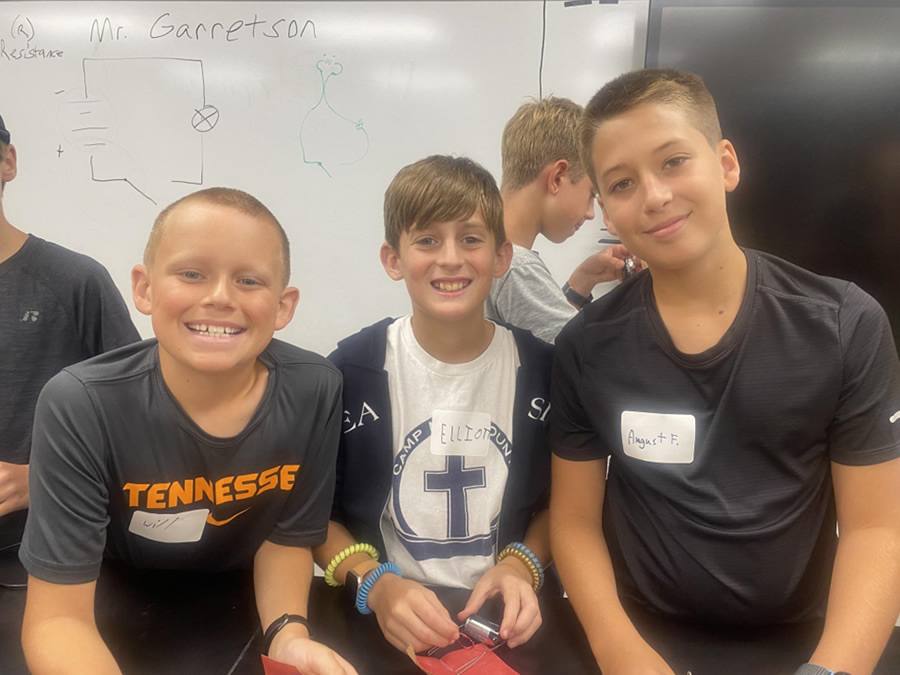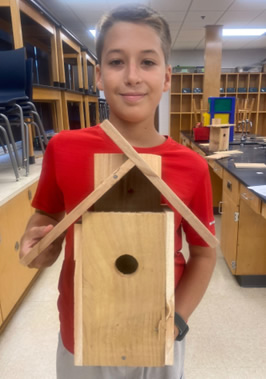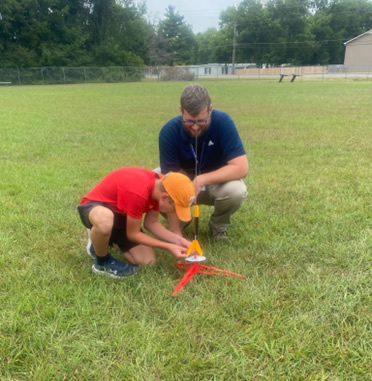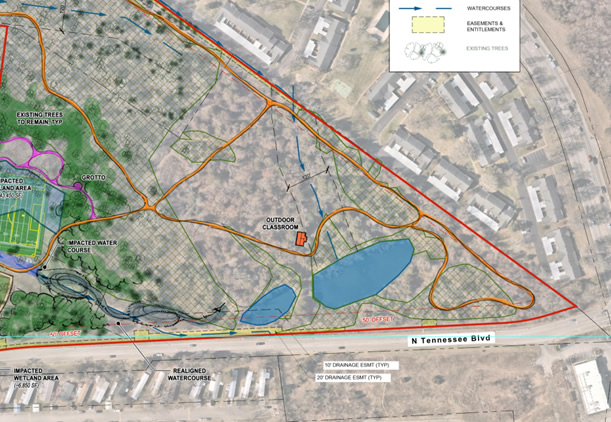STEM/Science Olympiad
Science Olympiad Bootcamp Success!
by Ben Garretson on July 27, 2024
Who am I? I converted to Catholicism at age 7. Prayer has always kept me grounded. I especially love the Saints Dominic, Thomas Aquinas, Rose of Lima, Albert Magnus, and Blessed Frassati. I have experience in small business management, healthcare information technology, and most recently in management of the Middle Tennessee State University Experimental Vehicles Program (right) as well as the Control and Automation Lab where I researched Precision Agriculture for the past two years. I plan to leverage this experience to help Saint Rose better compete in the Science Olympiad, and in presenting research conducted at Saint Rose for the MTSU STEM Expo. I am investigating other opportunities outside the MTSU sphere as well and am open to ideas.
It is my goal to present the first principles of science and engineering through my witness of the compatibility of faith and reason in my life and in my classroom. We will learn to make things in the lab this year, hypothesize, conduct experiments, make inferences, and present our research findings. Iterative design and testing will be emphasized wherever possible. In future I plan for students to write the articles contained below.
Summer 2024 Science Olympiad Camp Recap
by Ben Garretson on July 27, 2024
Our Science Olympiad Summer Camp was a huge success. We explored and engaged in hands-on scientific learning. This camp taught students about the processes, tools, and materials they will need to take on the events from the 2025 Division B Science Olympiad and provided a unique opportunity for students to immerse themselves in various scientific disciplines. The camp covered all of the follow topics:

Photo by Sister Catherine Marie
Day 1: Electricity and Basic Circuits
- Lemon Battery (Multimeter usage for continuity and DC voltage, basic circuit notation)
- Battery Motor (Basics of electromagnetic induction, Difference between 28 and 8 AWG copper wire, implications of safety in circuit resistance in house wiring versus DC devices in an electric scooter or golf cart, use of desktop DC power supply, generated volts with a small DC brushed motor, concept of Electrostatic Discharge in precision electronics, transistor gates)
- Began assembly of solar powered walking robots and asked students to recall where the energy came from in the lemons versus the solar panels.

Learning to use the microscope - photo by Sister Catherine Marie
Day 2: Woodland Sample Collection and Microscope
- Collected various soil, water, insects, and one small frog named Albert.
- Taught students how to prepare slides, mount to microscope, focus different lenses in sequence and the difference in their magnification. Taught right hand ruled XYZ machinery and likened microscope to 3D printer, upright mill/drill press, laser engraver, dental implant fabrication etc.). Taught proper PPE and importance of safety in the lab. Taught students how to access bone marrow with a drill press for viewing.
Day 3: Audubon Wednesday

Photo by Sister Catherine Marie
- Cedar plank birdhouses. Whoever gets a bluebird to live in their house will receive extra credit. After making all cuts on table saw before students arrived for camp, I brought students into the Marion House to pick up wood and look at saw and reiterate how right hand rule XYZ logic in machinery impacts various engineering pursuits in precision.
- Taught students to use hammer and nails to construct birdhouses. Taught students the concept of flat in engineering and showed them ways to improve structural soundness of their bird houses without stifling creativity. Taught students to operate hand drill with direct supervision and to observe heat from friction in the wood and metal. Advised students of the difference between a toy and a tool. Advised students that if we were drilling holes in steel or aluminum it would be hot enough to burn them. Showed students how to use a professional digital invisible laser thermometer and demonstrated the difference in temperature on the forehead versus extremities.
- Took students outside and taught safety principles of a scientific test rocket
- launch using bicycle pump with plastic bottle water launch system. Tested temperatures at various points of the playground.
Day 4: Flight Day 1

Photo by Sister Catherine Marie
- Constructed Estes Rockets Model 1751 Alpha III rockets. Taught students about safety using hobby knives and super glue with PPE gloves. Reemphasized the difference between toys and tools. Taught students how to use mechanical and chemical assembly techniques in line with the rocket instructions. Showed them the launch pad and control for launching the rockets and explained how the simple circuit that sparks rocket engine propellant is alike and different from the lemon batteries they made.
- Had students use rubber band driven propeller balsa wood chassis and attach wings and stabilizers cut from their own designs in manila card stock folders. Went over basics of flight. A couple flew on the roof. Current competitive Science Olympiad “Flight” Div B flight times are over 1 minute indoors with saran wrap wings that were cut with a laser engraver and a drill to spin up the propeller to over 1k revolutions.
Flight: 2
- Completed Solar Robots. Learned about various mechanical principles of Assembly and the workings of gears in a drive system to create repetitive bipedal motion in a small toy robot.
- Launched Estes rockets using safety procedures learned in the water rocket procedure from earlier in the week. N.B. Next year I will order the smaller rocket engines much earlier as these Hobby Lobby motors turned out to reach 1350’ and so I am still trying to figure out where a few of them ended up. If you see an orange rocket around Saint Rose’s campus let me know exactly where at once to see if my math checks out on possible drift locations. Students learned about the NASA Artemis I, II, and III missions and watched a video on the delta-v fuel savings versus the Apollo missions' relatively fuel hungry maneuvers. Students learned that the gross smell is from the black powder fuel that contains charcoal, sulfur, and potassium nitrate www.nasa.gov/mission/artemis-ii/
New Editions to Our Research Forest
by Ben Garretson on July 27, 2024

Early concept map of St. Rose of Lima woodlands
I am excited to share that our research forest will soon feature new agroforestry exhibits (“Several kinds of mushrooms grow naturally in woodlots…” p. 91) and a pollinator botanical garden. These additions will serve as living laboratories for our students, allowing them to conduct research and participate in hands-on learning experiences. The USDA NRCS team working with Dr. Leslee Dodd is currently examining our wetlands due to the recent finding of a “species of concern” Streamside Salamander, and we anticipate their recommendations to further enhance our conservation efforts. I plan to have seventh grade students in teams to further investigate these salamanders, owls, and other species living in the forest. We are considering applying for arboretum status. I am searching for an Eagle Scout Project for creating an outdoor classroom of some degree. I would love to have 7th graders put up trailcams to watch for wildlife and to let Officer Vance keep an eye on the goings on out in the woods.
Scoutmaster of Troop 538 Norbert Braunwalder, Tenderfoot John Jackson, and myself walked the trails the morning of July 19, 2024 to discuss the possibility of installing two honey beehives in the northern part of the woodlands once the Chinese Privet is removed, and possibly a small canoe launch to let our older students get up close with the ecology of the wetlands. It’s an exciting time to be out in the woods at Saint Rose of Lima.
STEM Center of Excellence
by Ben Garretson on July 27, 2024

MTSU NASA Rover milling a curved surface - photo by Ben Garretson
Our journey towards becoming the parochial STEM Center of Excellence is well underway. This initiative aims to provide our students with enhanced interdisciplinary learning opportunities in science, technology, engineering, and mathematics. We are collaborating with various organizations, including the MTSU Math and Science Education doctoral program, the MTSU Mechatronics Engineering Department’s Control and Automation Lab, and the USDA NRCS, among others, to secure grant funding and research opportunities for the students to learn to prepare them for pursuing a career in science or engineering.
Our Computer Lab has a new 3D printer for this Fall. I would encourage any potential engineering students (and all of the seventh and eighth graders) to create a student account with their @saintrose.org email at www.onshape.com/en/ which is the official Computer Aided Design (CAD) software for the Science Olympiad Division B this year and will enable students to create, for example, custom model rocket nose cones and run computational fluid dynamics simulations on them before 3D printing one out to test them in reality to create a superior launch experiences. Or a robot chassis to mount drone motors and wheels to race around the perimeter of the school, or to create a musical instrument with specific qualities, etc. There are plenty of tutorials to start tinkering from any computer web browser on onshape.com. Or to examine a GIS CAD file with every tree with a bigger than 6” diameter trunk, species, and GIS coordinates from 2019 Forestry Study of St. Rose’s trees.
On my Science Teacher Amazon wishlist, in addition to the mail order hermit crabs there is a CNC Laser Engraver and a Desktop CNC Router. These models are on the upper price side of hobby devices and can be put inside boxes to make them education friendly and deny students access if they enter the classroom after hours. I am open to other models (Langmuir MR-1) or secondhand devices or from other companies than Amazon or discussion about anything on the list if any engineer or scientist has knowledge. I want to shift from purchasing premade Science Olympiad kits to showing our students how to design and then print or cut parts out of MDF wood, plastic and metal with precision machines. If we do go this route we will need safety gear that is appropriate. But there is no point asking for the laser proof goggles without the laser engraver to cut the plastic gear wheels for the jar of pennies gravity action clock that will take 3 months to hit the ground.
Preparing for the New School Year
by Ben Garretson on July 27, 2024
As we prepare for the new school year, I encourage all students to stay curious and engaged with science. Read books, articles, build things, get outside and explore the natural world, and most importantly, write about what you learn!
I look forward to welcoming your child back to school in the fall and embarking on an exciting year of discovery and growth. If you have any questions or need further information about the Science Olympiad or other STEM initiatives, please do not hesitate to contact us.